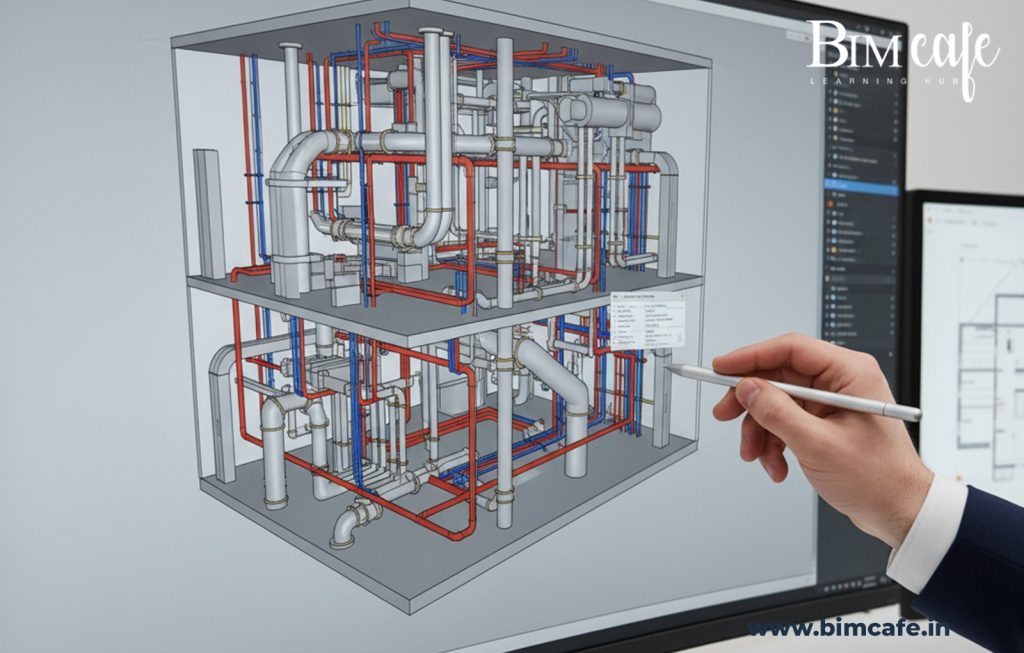
Author: Devika R
November 10, 2025
7 min read
Why a BIM Internship is the Smartest Way to Start Your Career
In today’s fast-evolving construction landscape, Building Information Modelling (BIM) has become the foundation of modern design and project management. No longer limited to 3D modelling, BIM integrates architecture, engineering, and construction data into a single intelligent platform — making it one of the most sought-after digital skills in the global AEC (Architecture, Engineering, and Construction) industry.
Whether you’re an aspiring architect, a civil engineer, or a construction professional, a BIM internship is your first real opportunity to step into this world of intelligent design and digital collaboration. It allows you to apply classroom knowledge to real projects, experience how data-driven models improve coordination, and understand how your contributions fit into a larger construction ecosystem.
Unlike theoretical learning, internships expose you to real client projects, interdisciplinary teamwork, and practical workflows using tools such as Autodesk Revit, Navisworks, and AutoCAD. You’ll observe how BIM managers make critical decisions, how clash detections prevent costly errors, and how model-based planning leads to faster, safer, and more sustainable construction outcomes.
Suppose you’re serious about building a future-ready career. In that case, this guide walks you through everything you need to know — from how to secure your first BIM internship to the skills, strategies, and structured learning paths that can help you grow into a global BIM professional.
Understanding BIM Internships: A Launchpad for Real-World Experience
A BIM internship is more than a short-term training period — it’s a practical gateway that connects your academic foundation to industry expertise. These programs immerse you in active design and construction environments, where digital models represent every detail of a project, and collaboration drives every decision.
During a BIM internship, you’ll gain firsthand exposure to:
- Advanced BIM Software: Work with tools such as Revit, Navisworks, and AutoCAD to model, analyze, and coordinate real structures.
- Project Workflows: Learn how architects, structural engineers, and MEP teams exchange data and collaborate seamlessly within a shared model.
- Data-Driven Construction: Understand how 3D models evolve into 4D and 5D simulations, integrating time and cost dimensions for accurate project management.
- Interdisciplinary Collaboration: Experience working in multi-department teams, where each contribution supports a collective design vision.
- Documentation and Coordination: Participate in preparing detailed sheets, resolving clashes, and maintaining consistent documentation across project phases.
By the end of your internship, you’ll be equipped with practical insights that go far beyond software skills — you’ll understand the real-world challenges of design execution, the importance of data integrity, and the value of communication in large-scale construction projects.
How to Secure a BIM Internship: Step-by-Step Guide
Finding the right BIM internship takes strategic preparation. Here’s a step-by-step approach to help you stand out in a competitive field:
1. Build a Strong Technical Foundation
Employers expect interns to have at least a working knowledge of BIM tools. Start by learning the basics of Revit Architecture, AutoCAD, or other entry-level CAD applications. Consider completing a short certified course that covers modelling, parametric design, and documentation — this builds your technical confidence before stepping into a professional environment.
2. Create a Portfolio that Reflects Your Skills
Your portfolio is your visual resume. Include academic projects, conceptual designs, or BIM-based models that demonstrate your understanding of design coordination, detailing, or rendering. Highlight any real-world applications — even student projects — that show how you’ve applied theoretical knowledge to solve design challenges.
3. Network and Engage with Industry Professionals
Join online BIM forums, participate in webinars, and connect with experts on LinkedIn. Engage with posts, share your learnings, and express interest in upcoming internships. Most opportunities arise through professional connections and referrals.
4. Research and Choose the Right Training Partner
Look for programs that go beyond software instruction to offer industry exposure and placement support. Institutions like BIM Café are known for their structured learning-to-placement pathway, helping students gain both hands-on project experience and direct entry into BIM-related roles in the UAE and abroad.

Why BIM Internships Matter for Global Opportunities
As construction becomes increasingly digital, BIM has evolved into a global standard for design, collaboration, and project delivery. Leading economies — from the UAE and UK to Singapore and Australia — now mandate BIM in public infrastructure projects, ensuring higher productivity, transparency, and sustainability.
A BIM internship opens doors to these global opportunities by helping you:
- Gain practical experience aligned with international BIM Level 2 and ISO 19650 standards.
- Understand how multidisciplinary teams operate across borders using unified digital platforms.
- Build a professional profile recognized worldwide, giving you an edge in international recruitment.
Moreover, the Middle East, particularly the UAE and Saudi Arabia, is experiencing a major BIM-driven transformation — from smart city developments and metro expansions to landmark architectural projects. Graduates with relevant BIM internship experience are highly valued for their ability to integrate into global project teams with minimal onboarding time.
In short, a BIM internship doesn’t just enhance employability — it positions you for long-term international growth in a sector that values innovation, collaboration, and digital intelligence.
Essential Skills You’ll Develop During a BIM Internship
A successful BIM professional must combine technical expertise with analytical thinking and collaboration. Through an internship, you’ll gain exposure to the full BIM ecosystem and develop the following in-demand skills:
- Revit Modelling (Architecture, Structure, and MEP): Learn to create detailed, parametric models and understand how they interact across disciplines.
- BIM Coordination & Clash Detection (Navisworks): Detect and resolve interferences between systems, ensuring seamless project integration.
- BIM Execution Planning (BEP): Understand the strategic framework for managing BIM processes across the project lifecycle.
- Data and Document Management: Organize drawings, schedules, and model data to maintain consistency throughout design and construction.
- Collaboration in Common Data Environments (CDE): Learn to exchange information across teams using cloud-based project platforms.
- Understanding LOD (Level of Detail) and LOI (Level of Information): Gain clarity on how data-rich models evolve from concept to construction-ready documentation.
These skills not only improve your job-readiness but also provide a strong base for higher career paths such as BIM Modeler, Coordinator, or BIM Engineer — roles that are currently in high demand across international markets.
Comparative Overview: Key Global BIM Internship Opportunities
To understand the scope and value of a BIM internship, it’s important to compare how internship programs differ across leading regions. The table below outlines the key differences in focus areas, technologies, and career outcomes — helping you benchmark what to expect from global BIM opportunities.
| Region / Country | Industry Focus | Primary BIM Tools Used | Internship Outcomes / Skills Gained | Career Pathways |
| UAE & Middle East | Smart cities, metro projects, mixed-use developments | Revit, Navisworks, BIM 360 | Exposure to ISO 19650 workflows, clash detection, and digital twin applications | BIM Modeler → BIM Engineer → BIM Manager |
| United Kingdom (UK) | Infrastructure, healthcare, and public sector projects | Revit, Synchro, ArchiCAD | Compliance with BIM Level 2 standards, documentation control, and 4D simulations | BIM Coordinator → Project BIM Lead → Information Manager |
| Singapore | High-rise & smart city projects | Revit, Dynamo, Navisworks | Sustainability-focused modelling, integrated digital delivery (IDD) workflows | BIM Specialist → Sustainability Consultant → IDD Manager |
| Australia | Transportation, utilities, and sustainable housing | Revit, Civil 3D, Navisworks | Hands-on project delivery exposure, environmental and cost modelling | Junior Modeler → BIM Technician → Digital Delivery Lead |
| United States (US) | Commercial, industrial, and retrofit projects | Revit, AutoCAD, Navisworks, InfraWorks | Advanced coordination, construction sequencing, and BIM for facilities management | BIM Designer → Virtual Design & Construction (VDC) Engineer → BIM Director |

Global BIM Adoption Trends: Where the Opportunities Are Growing
Governments and private sectors worldwide are embracing BIM as a standard tool for efficiency and sustainability. The UAE, UK, Singapore, and Saudi Arabia have integrated BIM requirements into public contracts, while Australia and the US continue to expand BIM’s role in infrastructure planning and smart city initiatives.
For BIM-trained professionals, this translates into opportunities across diverse sectors:
- Smart City Planning & Design: Integrating digital twins and IoT data into city infrastructure.
- Transportation & Infrastructure: Designing airports, metros, and highways through coordinated 3D modelling.
- Sustainable Architecture: Using BIM for energy modelling, green certification, and lifecycle analysis.
- Oil, Gas & Industrial Projects: Managing complex plant designs and retrofitting operations with precision.
By joining an internship that mirrors these global BIM frameworks, candidates position themselves for high-value careers — capable of contributing to international projects and advancing toward globally recognized certifications.
The Global BIM Talent Gap – Why Skilled Professionals Are in Demand Everywhere
While BIM adoption is accelerating across industries, the supply of skilled professionals hasn’t caught up with the demand. Global construction reports consistently highlight a widening BIM talent gap, especially in roles that require both technical proficiency and project management insight.
Many organizations are eager to implement BIM workflows but struggle to find experts who can lead model coordination, ensure information integrity, and drive collaboration between architecture, structural, and MEP teams. This gap has created unprecedented opportunities for new entrants who combine formal BIM training with hands-on experience.
A BIM internship plays a crucial role in bridging this divide. Beyond mastering tools like Revit or Navisworks, interns learn how to think like digital collaborators — interpreting models, managing data flows, and aligning with global standards such as ISO 19650. These experiences signal to employers that you not only understand BIM technology but also possess the communication, adaptability, and analytical thinking required for modern, multidisciplinary teams.
How BIM Shapes Smart Cities and Mega Infrastructure Projects Worldwide
BIM isn’t limited to design visualization — it’s the foundation of smart infrastructure. Across the globe, cities are embracing BIM and digital twin technologies to optimize how they design, build, and maintain public assets. From Dubai’s futuristic skyline to Singapore’s smart city framework and London’s Crossrail project, BIM ensures that data drives every phase of development.
Through 3D and 4D modelling, BIM helps planners anticipate clashes, improve sustainability, and reduce lifecycle costs. It allows governments and private developers to make data-driven decisions — from energy efficiency to resource optimization.
For interns, participating in such projects offers a front-row seat to the future of construction technology. You’ll witness how integrated BIM systems influence large-scale decision-making, sustainability practices, and digital asset management — providing exposure that can fast-track your transition into high-impact global roles.
Cross-Cultural Collaboration: Working on International BIM Teams
Today’s BIM ecosystem operates without borders. Major construction projects often bring together architects in Europe, engineers in the Middle East, and contractors in Asia — all working on the same model in real time. This cross-cultural collaboration has become a defining feature of modern AEC workflows.
Internships that replicate this international dynamic prepare you to work effectively with global teams. You’ll learn how to navigate differences in communication styles, design standards, and time zones — while maintaining seamless coordination through cloud-based BIM platforms and common data environments (CDEs).
Developing cultural intelligence and adaptability is just as vital as technical skill. Professionals who can collaborate across languages and disciplines are increasingly sought after by multinational firms. A well-structured BIM internship helps cultivate this versatility, shaping you into a confident, globally competent team player ready for international project environments.

Earning Potential and Career Growth in Global BIM Markets
As BIM adoption expands globally, career prospects and salary packages continue to rise across every tier of the industry. Entry-level professionals often start as BIM interns or junior modelers, gaining invaluable exposure to live projects. With experience, they progress to BIM coordinators, BIM engineers, and eventually BIM managers or digital delivery leads overseeing entire project lifecycles.
According to industry reports, BIM specialists command premium salaries in regions like the UAE, UK, and Singapore — where demand outpaces local talent availability. For professionals with international project exposure and recognized training, the opportunities multiply, extending to roles in consultancy, project management, and digital transformation.
A BIM internship backed by credible industry certification not only accelerates your entry into the workforce but also enhances your long-term career trajectory. With structured mentorship, continuous upskilling, and real-world project experience, you can transform your internship into a launchpad for global career growth — progressing from a student of technology to a leader shaping the built environment of tomorrow.

BIM Cafe’s Structured Internship Pathway: Learn, Apply, and Get Placed
Breaking into the world of Building Information Modelling (BIM) requires more than just software knowledge — it takes structured training, real-world exposure, and guided mentorship. BIM Cafe bridges this gap through its career-focused BIM Internship Pathway, designed to help students and professionals gain hands-on experience, build strong portfolios, and secure successful industry placements.
1. BIM Professional Course – Mastering Project-Level BIM Skills
This course equips learners with real-world skills required for BIM roles across Architecture, Structure, and MEP domains. Through industry simulation projects, you’ll learn modelling, documentation, and coordination workflows — exactly how real BIM teams operate. Ideal for graduates and early-career professionals ready to enter the BIM workforce.
2. BIM Master Course – From Learner to Leader
The Master Course is for those aspiring to grow into specialist and leadership roles in the BIM industry. Beyond advanced modelling, you’ll work on BIM Execution Plans, interdisciplinary coordination, clash detection, and collaboration workflows. Graduates often secure roles in top engineering firms, design consultancies, and global BIM teams.
3. BIM Software Online Course – Learn Anytime, Anywhere
A flexible online pathway designed for college students and working professionals. Learn industry-standard BIM tools like Revit, Navisworks, and AutoCAD at your own pace — with mentorship, assignments, and live support. Perfect for those who want structured learning with convenience and flexibility.
4. Revit Architecture Course – Specialised Architectural BIM Training
Master Revit for architectural design and documentation. This course focuses on creating detailed building models, schedules, and sheets with accuracy and efficiency. By learning Revit architecture workflows, you build skills that modern architecture firms prioritize for hiring.
5. Architectural Engineering Course – Design Meets Technology
A future-oriented program that integrates architectural design fundamentals with engineering and BIM workflows. Learn how design intent and technical systems work together to deliver sustainable, functional, and globally compliant buildings. Ideal for architecture & civil engineering students aiming to work on international projects.
Each course includes mentorship, project-based learning, and internship opportunities — ensuring students gain both technical mastery and career placement support.

Conclusion: Your First Step Toward a Global BIM Career
Securing your first BIM internship is more than a learning experience — it’s the first step toward a rewarding, future-proof career in the global AEC (Architecture, Engineering, and Construction) industry.
With structured learning, hands-on exposure, and professional guidance, you can transform your passion for design and technology into a thriving international career.
Ready to begin your BIM journey?
Explore BIM Cafe’s internship and training opportunities today.
Contact BIM Cafe to learn more about enrollment, mentorship, and placement support.




